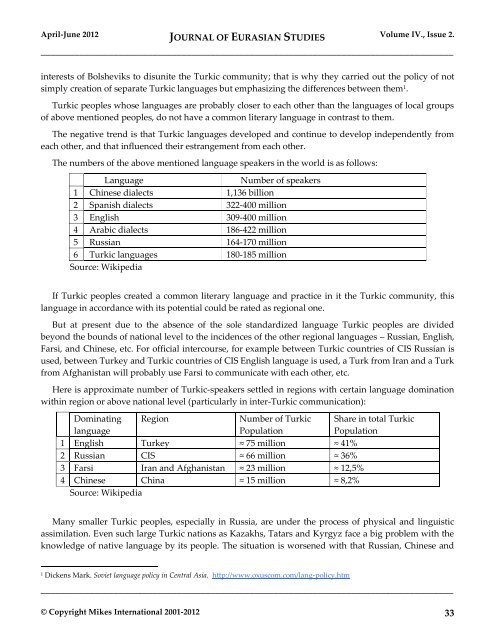Create successful ePaper yourself
Turn your PDF publications into a flip-book with our unique Google optimized e-Paper software.
April-June 2012 JOURNAL OF EURASIAN STUDIES Volume IV., Issue 2.<br />
_____________________________________________________________________________________<br />
interests <strong>of</strong> Bolsheviks to disunite the Turkic community; that is why they carried out the policy <strong>of</strong> not<br />
simply creation <strong>of</strong> separate Turkic languages but emphasizing the differences between them 1 .<br />
Turkic peoples whose languages are probably closer to each other than the languages <strong>of</strong> local groups<br />
<strong>of</strong> above mentioned peoples, do not have a common literary language in contrast to them.<br />
The negative trend is that Turkic languages developed and continue to develop independently from<br />
each other, and that influenced their estrangement from each other.<br />
The numbers <strong>of</strong> the above mentioned language speakers in the world is as follows:<br />
Language Number <strong>of</strong> speakers<br />
1 Chinese dialects 1,136 billion<br />
2 Spanish dialects 322-400 million<br />
3 English 309-400 million<br />
4 Arabic dialects 186-422 million<br />
5 Russian 164-170 million<br />
6 Turkic languages 180-185 million<br />
Source: Wikipedia<br />
If Turkic peoples created a common literary language and practice in it the Turkic community, this<br />
language in accordance with its potential could be rated as regional one.<br />
But at present due to the absence <strong>of</strong> the sole standardized language Turkic peoples are divided<br />
beyond the bounds <strong>of</strong> national level to the incidences <strong>of</strong> the other regional languages – Russian, English,<br />
Farsi, and Chinese, etc. For <strong>of</strong>ficial intercourse, for example between Turkic countries <strong>of</strong> CIS Russian is<br />
used, between Turkey and Turkic countries <strong>of</strong> CIS English language is used, a Turk from Iran and a Turk<br />
from Afghanistan will probably use Farsi to communicate with each other, etc.<br />
Here is approximate number <strong>of</strong> Turkic-speakers settled in regions with certain language domination<br />
within region or above national level (particularly in inter-Turkic communication):<br />
Dominating Region Number <strong>of</strong> Turkic Share in total Turkic<br />
language<br />
Population<br />
Population<br />
1 English Turkey ≈ 75 million ≈ 41%<br />
2 Russian CIS ≈ 66 million ≈ 36%<br />
3 Farsi Iran and Afghanistan ≈ 23 million ≈ 12,5%<br />
4 Chinese China ≈ 15 million ≈ 8,2%<br />
Source: Wikipedia<br />
Many smaller Turkic peoples, especially in Russia, are under the process <strong>of</strong> physical and linguistic<br />
assimilation. Even such large Turkic nations as Kazakhs, Tatars and Kyrgyz face a big problem with the<br />
knowledge <strong>of</strong> native language by its people. The situation is worsened with that Russian, Chinese and<br />
1 Dickens Mark. Soviet language policy in Central Asia. http://www.oxuscom.com/lang-policy.htm<br />
_____________________________________________________________________________________<br />
© Copyright Mikes International 2001-2012 33
















